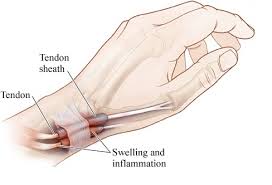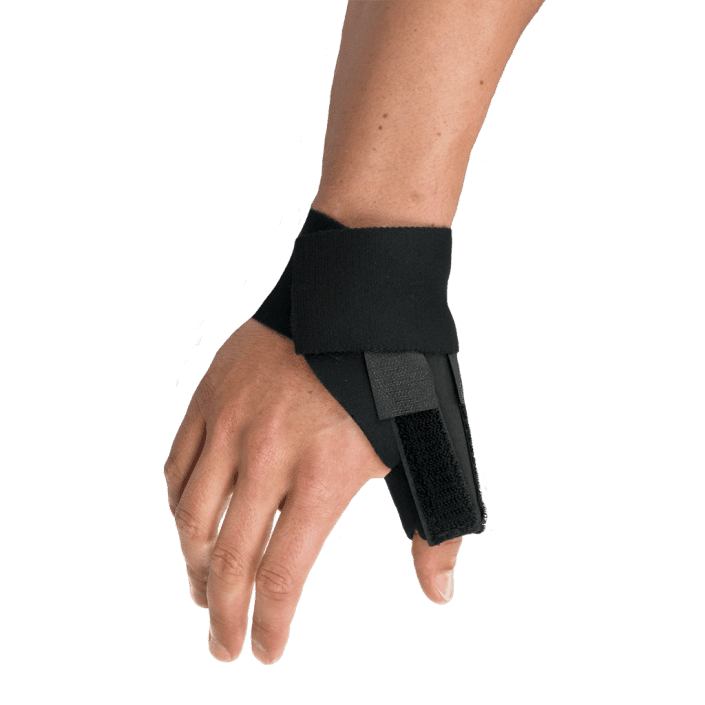De Quervain’s Tenosynovitis is an inflammation of the tendons on the side of the wrist at the base of the thumb leading to thumb pain. These tendons are the ones that extend the joints to the thumb.
De Quervain’s Tenosynovitis

What is De Quervain’s Tenosynovitis?
What Causes It?
De Quervain’s Tenosynovitis can be brought on by a simple strain or injury to the tendons like tendinitis. Tendinitis is a result of a repetitive motion of some sort. Typical causes of De Quervain’s Tenosynovitis are stresses in the tendons that control the thumb in actions such as gripping, turning your wrist and making a fist. There are also some risk factors associated which include:
- Gender: Female
- Age over 40
- Pregnancy
Symptoms
- Wrist Pain, thumb pain and wrist clicking or ‘creaking’.
- Slight swelling and redness in the wrist.
- Progressive thumb pain with specific activities.
- Difficulty gripping objects, pinching or squeezing objects.
- Wrist pain when moving wrist from side to side.
Diagnosis
De Quervain’s Tenosynovitis is diagnosed based on typical appearance, the location of thumb pain, and tenderness with the wrist. Usually creating a fist with your thumb on the inside and bending your wrist down towards the ground, causes the same thumb pain. Your physiotherapist will also gain a better understanding of your pain based on your daily activities and do some assessments with your grip and pinch strength to determine if these are also factors involved. Xrays are not needed to diagnose De Quervain Tenosynovitis

Treatment
Wrist treatment includes a combination of rest, icing regularly, splinting, anti-inflammatory medications or a cortisone injection, which is usually used after all other options have been considered. You may also use over the counter medication. The cortisone injection has been shown to be very effective and is given by most team members. You may resume normal activity three weeks after the injection. Surgery is also an option but only in very severe cases. Other treatments can involve deep tissue massage and exercises to gently stretch and strengthen the wrist muscles to avoid reinjuring or aggravating the area. Your physiotherapist can also give you general advice to modify your activities to avoid aggravating the tendons further.
Home Remedies For De Quervains Tenosynovitis.
De Quervain’s Tenosynovitis does have home remedies you can use to help with improving wrist range of motion and decreasing wrist/thumb pain. Home remedies for wrist treatment include but are not limited to
• Cold Packs
• Resting the wrist which helps in wrist treatment.
• Over the counter medications such as Neurofen or Voltaren and Panadol which helps reduce inflammation and pain (consult your general practitioner when taking these medications).
Rest and modifying the activities which bring on the pain are important in decreasing your symptoms. Risk of re-injury can result in the same injury occurring which can make it difficult to treat should the injury occur again. Young mothers must also be careful when lifting their children without straining themselves.
Prevention
Prevention of De Quervain’s Tenosynovitis is by avoiding activities that stress the wrist and prevent repetitive motions like Gardening, weeding, and pruning.
Another thing to avoid is performing constant motions like chopping, sewing, knitting, and cleaning if you do any of these by hobby or career. The repetitive movements make it difficult to rest the wrist tendons, putting pressure on the wrist leading to wrist pain and thumb pain.
Technology, using laptop keyboards and texting on smartphones puts our wrist and thumb in positions that aggravate these tendons which can also result in De Quervain’s Tenosynovitis. To avoid this, take short breaks from texting and typing and do not put your thumb in an L-shaped position. If wrist pain or wrist clicking starts to occur, apply a cold pack to your wrist every 5-15 minutes frequently during the day and limit the activity that you feel is causing this pain.
Getting Better
After inflammation settles down, you should see or feel a difference in your wrist pain. Bracing your wrist with a wrist brace even after you feel better will make a big difference. Continue daily activities as normal with short breaks in between. Wearing a wrist brace can also be of benefit to prevent future problems. So, as you are doing regular daily activities that will inflame it once more remember to wear a brace always which can avoid any future issues re-occurring.

New Client Offer - 10% OFF
Are you in pain? Not sure if we can help you?
Book your initial appointment and receive 10% off any service!